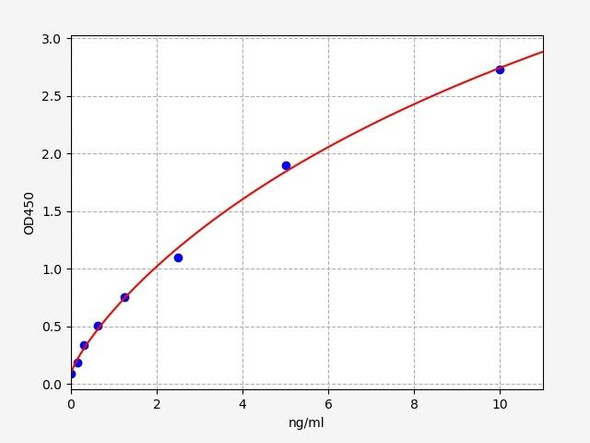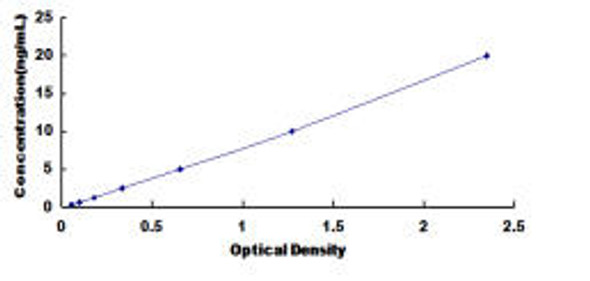Human FOXO1 (Forkhead Box Protein O1) ELISA Kit (HUES02193)
- SKU:
- HUES02193
- Product Type:
- ELISA Kit
- Size:
- 96 Assays
- Uniprot:
- Q12778
- Sensitivity:
- 0.09ng/mL
- Range:
- 0.16-10ng/mL
- ELISA Type:
- Sandwich
- Synonyms:
- FOX-O1, FKH1, FKHR, FOXO1A
- Reactivity:
- Human
- Sample Type:
- Serum, plasma and other biological fluids
- Research Area:
- Cell Death
Description
Human FOXO1 (Forkhead Box Protein O1) ELISA Kit
The Human Foxo1 (Forkhead Box Protein O1) ELISA Kit is specifically designed for the accurate detection of Foxo1 levels in human serum, plasma, and cell culture supernatants. This kit offers high sensitivity and specificity, ensuring precise and consistent results for a variety of research applications.Foxo1 is a key transcription factor that regulates various cellular processes such as metabolism, apoptosis, and cell cycle progression.
Dysregulation of Foxo1 has been implicated in conditions like diabetes, cancer, and autoimmune diseases, highlighting its importance as a potential biomarker for studying and treating these diseases.With its reliable performance and comprehensive applications, the Human Foxo1 ELISA Kit from Assay Genie is an essential tool for researchers looking to explore the role of Foxo1 in health and disease.
| Assay type: | Sandwich |
| Format: | 96T |
| Assay time: | 4.5h |
| Reactivity: | Human |
| Detection Method: | Colormetric |
| Detection Range: | 0.16-10 ng/mL |
| Sensitivity: | 0.10 ng/mL |
| Sample Volume Required Per Well: | 100µL |
| Sample Type: | Serum, plasma and other biological fluids |
| Specificity: | This kit recognizes Human FOXO1 in samples. No significant cross-reactivity or interference between Human FOXO1 and analogues was observed. |
This ELISA kit uses Sandwich-ELISA as the method. The micro ELISA plate provided in this kit has been pre-coated with an antibody specific to Human FOXO1. Standards or samples are added to the appropriate micro ELISA plate wells and combined with the specific antibody. Then a biotinylated detection antibody specific for Human FOXO1 and Avidin-Horseradish Peroxidase (HRP) conjugate are added to each micro plate well successively and incubated. Free components are washed away. The substrate solution is added to each well. Only those wells that contain Human FOXO1, biotinylated detection antibody and Avidin-HRP conjugate will appear blue in color. The enzyme-substrate reaction is terminated by adding Stop Solution and the color turns yellow. The optical density (OD) is measured spectrophotometrically at a wavelength of 450 nm ± 2 nm. The OD value is proportional to the concentration of Human FOXO1. The concentration of Human FOXO1 in samples can be calculated by comparing the OD of the samples to the standard curve.
| UniProt Protein Function: | FOXO1A: a transcription factor of the forkhead family. A central regulator of metabolism in several cell types. May play an important role in myogenic growth and differentiation, and in the regulation of lipolysis in adipocytes by controlling the expression of adipose triglyceride lipase (ATGL), the rate-limiting lipolytic enzyme. Translocation of this gene with PAX3 has been associated with alveolar rhabdomyosarcoma. Contains 1 fork-head domain. |
| UniProt Protein Details: | Protein type:Nuclear receptor co-regulator; Oncoprotein; DNA-binding; Transcription factor Chromosomal Location of Human Ortholog: 13q14. 1 Cellular Component: cytoplasm; cytosol; mitochondrion; nucleoplasm; nucleus Molecular Function:beta-catenin binding; chromatin binding; protein binding; protein phosphatase 2A binding; sequence-specific DNA binding; ubiquitin protein ligase binding Biological Process: anatomical structure morphogenesis; apoptosis; autophagy; blood vessel development; cell differentiation; cell glucose homeostasis; cellular response to insulin stimulus; cellular response to starvation; endocrine pancreas development; epidermal growth factor receptor signaling pathway; fat cell differentiation; fibroblast growth factor receptor signaling pathway; innate immune response; insulin receptor signaling pathway; negative regulation of apoptosis; negative regulation of fat cell differentiation; negative regulation of stress-activated MAPK cascade; negative regulation of transcription from RNA polymerase II promoter; negative regulation of transcription, DNA-dependent; nerve growth factor receptor signaling pathway; phosphoinositide-mediated signaling; positive regulation of apoptosis; positive regulation of autophagy; positive regulation of gluconeogenesis; positive regulation of protein catabolic process; positive regulation of transcription from RNA polymerase II promoter; positive regulation of transcription, DNA-dependent; protein amino acid acetylation; response to DNA damage stimulus; thermoregulation; transcription, DNA-dependent Disease: Rhabdomyosarcoma 2 |
| NCBI Summary: | This gene belongs to the forkhead family of transcription factors which are characterized by a distinct forkhead domain. The specific function of this gene has not yet been determined; however, it may play a role in myogenic growth and differentiation. Translocation of this gene with PAX3 has been associated with alveolar rhabdomyosarcoma. [provided by RefSeq, Jul 2008] |
| UniProt Code: | Q12778 |
| NCBI GenInfo Identifier: | 116241368 |
| NCBI Gene ID: | 2308 |
| NCBI Accession: | Q12778. 2 |
| UniProt Secondary Accession: | Q12778,O43523, Q5VYC7, Q6NSK6, |
| UniProt Related Accession: | Q12778 |
| Molecular Weight: | |
| NCBI Full Name: | Forkhead box protein O1 |
| NCBI Synonym Full Names: | forkhead box O1 |
| NCBI Official Symbol: | FOXO1 |
| NCBI Official Synonym Symbols: | FKH1; FKHR; FOXO1A |
| NCBI Protein Information: | forkhead box protein O1 |
| UniProt Protein Name: | Forkhead box protein O1 |
| UniProt Synonym Protein Names: | Forkhead box protein O1A; Forkhead in rhabdomyosarcoma |
| Protein Family: | Foxo1-corepressor |
| UniProt Gene Name: | FOXO1 |
| UniProt Entry Name: | FOXO1_HUMAN |
As the OD values of the standard curve may vary according to the conditions of the actual assay performance (e. g. operator, pipetting technique, washing technique or temperature effects), the operator should establish a standard curve for each test. Typical standard curve and data is provided below for reference only.
| Concentration (ng/mL) | O.D | Average | Corrected |
| 10 | 2.265 2.283 | 2.274 | 2.208 |
| 5 | 1.505 1.507 | 1.506 | 1.44 |
| 2.5 | 0.872 0.842 | 0.857 | 0.791 |
| 1.25 | 0.421 0.427 | 0.424 | 0.358 |
| 0.63 | 0.272 0.25 | 0.261 | 0.195 |
| 0.32 | 0.168 0.156 | 0.162 | 0.096 |
| 0.16 | 0.107 0.125 | 0.116 | 0.05 |
| 0 | 0.062 0.07 | 0.066 | -- |
Precision
Intra-assay Precision (Precision within an assay): 3 samples with low, mid range and high level Human FOXO1 were tested 20 times on one plate, respectively.
Inter-assay Precision (Precision between assays): 3 samples with low, mid range and high level Human FOXO1 were tested on 3 different plates, 20 replicates in each plate.
| Intra-assay Precision | Inter-assay Precision | |||||
| Sample | 1 | 2 | 3 | 1 | 2 | 3 |
| n | 20 | 20 | 20 | 20 | 20 | 20 |
| Mean (ng/mL) | 0.55 | 1.05 | 4.23 | 0.56 | 1.01 | 3.96 |
| Standard deviation | 0.03 | 0.05 | 0.22 | 0.03 | 0.05 | 0.16 |
| C V (%) | 5.45 | 4.76 | 5.20 | 5.36 | 4.95 | 4.04 |
Recovery
The recovery of Human FOXO1 spiked at three different levels in samples throughout the range of the assay was evaluated in various matrices.
| Sample Type | Range (%) | Average Recovery (%) |
| Serum (n=5) | 88-102 | 95 |
| EDTA plasma (n=5) | 87-99 | 93 |
| Cell culture media (n=5) | 88-101 | 94 |
Linearity
Samples were spiked with high concentrations of Human FOXO1 and diluted with Reference Standard & Sample Diluent to produce samples with values within the range of the assay.
| Serum (n=5) | EDTA plasma (n=5) | Cell culture media (n=5) | ||
| 1:2 | Range (%) | 91-106 | 85-100 | 91-105 |
| Average (%) | 98 | 91 | 98 | |
| 1:4 | Range (%) | 92-103 | 82-97 | 85-98 |
| Average (%) | 97 | 89 | 91 | |
| 1:8 | Range (%) | 88-103 | 85-99 | 87-97 |
| Average (%) | 95 | 91 | 92 | |
| 1:16 | Range (%) | 91-106 | 84-98 | 89-101 |
| Average (%) | 97 | 89 | 95 |
An unopened kit can be stored at 4°C for 1 month. If the kit is not used within 1 month, store the items separately according to the following conditions once the kit is received.
| Item | Specifications | Storage |
| Micro ELISA Plate(Dismountable) | 8 wells ×12 strips | -20°C, 6 months |
| Reference Standard | 2 vials | |
| Concentrated Biotinylated Detection Ab (100×) | 1 vial, 120 µL | |
| Concentrated HRP Conjugate (100×) | 1 vial, 120 µL | -20°C(shading light), 6 months |
| Reference Standard & Sample Diluent | 1 vial, 20 mL | 4°C, 6 months |
| Biotinylated Detection Ab Diluent | 1 vial, 14 mL | |
| HRP Conjugate Diluent | 1 vial, 14 mL | |
| Concentrated Wash Buffer (25×) | 1 vial, 30 mL | |
| Substrate Reagent | 1 vial, 10 mL | 4°C(shading light) |
| Stop Solution | 1 vial, 10 mL | 4°C |
| Plate Sealer | 5 pieces | |
| Product Description | 1 copy | |
| Certificate of Analysis | 1 copy |
- Set standard, test sample and control (zero) wells on the pre-coated plate and record theirpositions. It is recommended to measure each standard and sample in duplicate. Note: addall solutions to the bottom of the plate wells while avoiding contact with the well walls. Ensuresolutions do not foam when adding to the wells.
- Aliquot 100 µL of standard solutions into the standard wells.
- Add 100 µL of Sample / Standard dilution buffer into the control (zero) well.
- Add 100 µL of properly diluted sample (serum, plasma, tissue homogenates and otherbiological fluids) into test sample wells.
- Cover the plate with the sealer provided in the kit and incubate for 90 min at 37 °C.
- Aspirate the liquid from each well, do not wash. Immediately add 100 µL of BiotinylatedDetection Ab working solution to each well. Cover the plate with a plate seal and gently mix. Incubate for 1 hour at 37 °C.
- Aspirate or decant the solution from the plate and add 350 µL of wash buffer to each welland incubate for 1-2 minutes at room temperature. Aspirate the solution from each well andclap the plate on absorbent filter paper to dry. Repeat this process 3 times. Note: a microplatewasher can be used in this step and other wash steps.
- Add 100 µL of HRP Conjugate working solution to each well. Cover with a plate seal andincubate for 30 min at 37 °C.
- Aspirate or decant the solution from each well. Repeat the wash process for five times asconducted in step 7.
- Add 90 µL of Substrate Reagent to each well. Cover with a new plate seal and incubate forapproximately 15 min at 37 °C. Protect the plate from light. Note: the reaction time can beshortened or extended according to the actual color change, but not by more than 30min.
- Add 50 µL of Stop Solution to each well. Note: Adding the stop solution should be done inthe same order as the substrate solution.
- Determine the optical density (OD value) of each well immediately with a microplate readerset at 450 nm.









